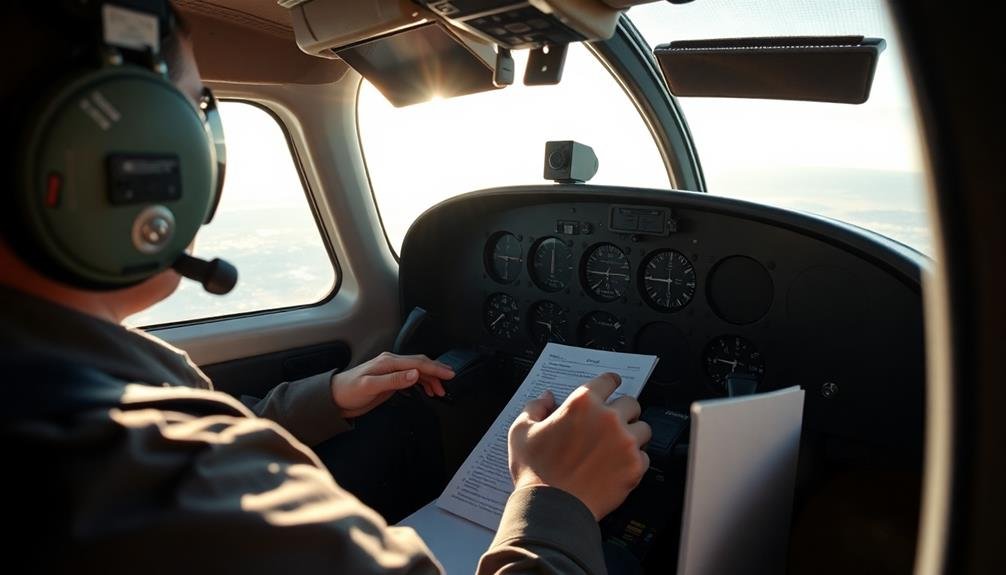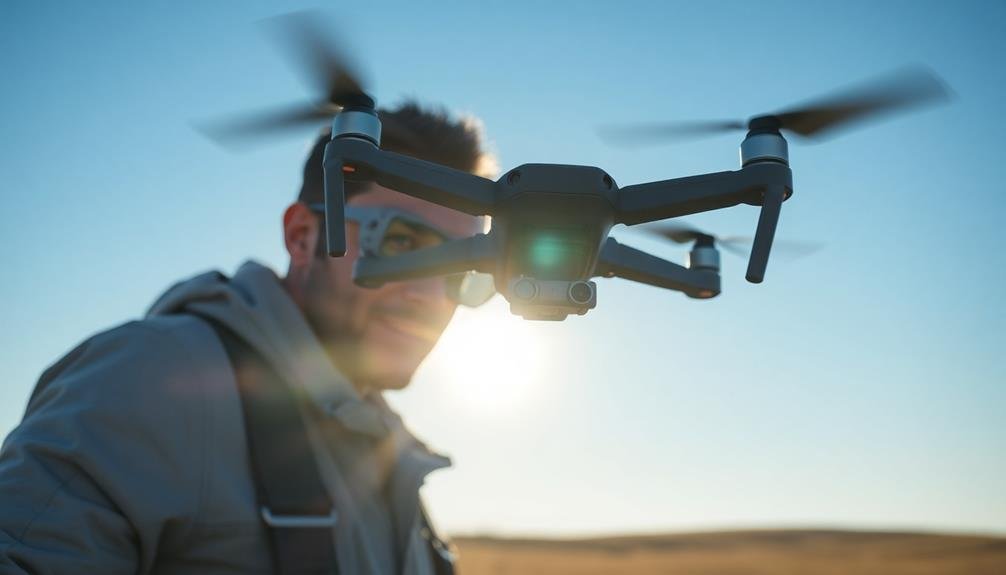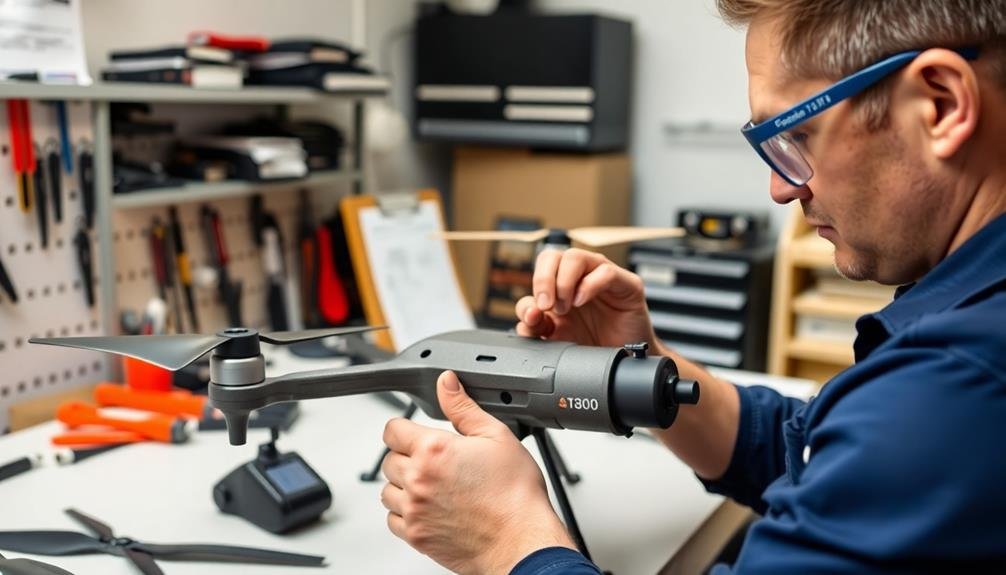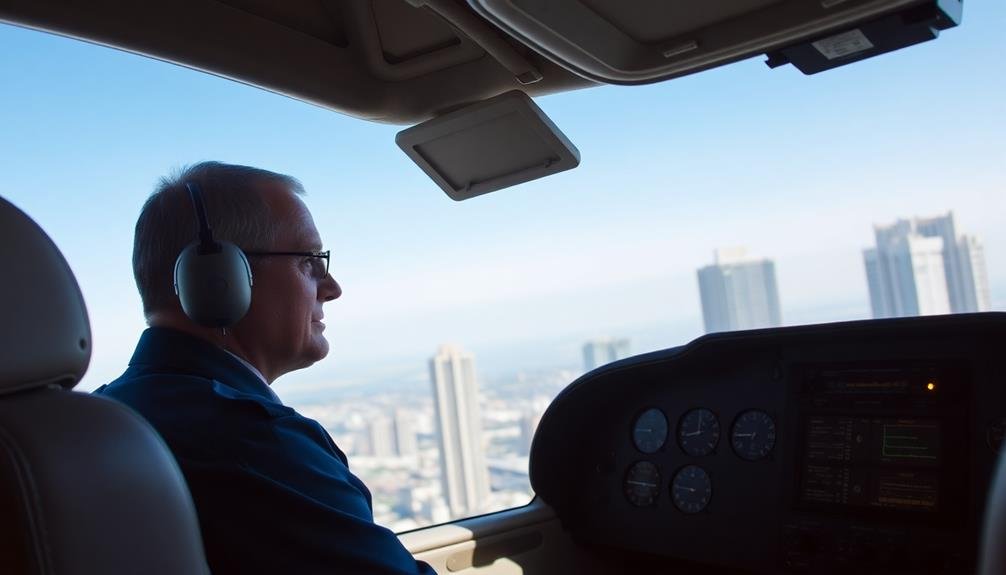When flying close-range, always conduct a pre-flight checklist and maintain visual line of sight with your aircraft. Respect no-fly zones and stay informed about local regulations. Monitor weather conditions closely and avoid flying in challenging environments. Master obstacle avoidance techniques and be prepared for emergency landings. Communicate effectively with nearby pilots and maintain your equipment properly. Consider legal and ethical implications of your flights, including privacy concerns. By following these safety rules, you'll minimize risks and maximize enjoyment. Dive deeper into each aspect to become a more responsible and skilled pilot.
Key Takeaways
- Maintain visual line of sight with the drone at all times to ensure immediate awareness of surroundings and potential hazards.
- Conduct a thorough pre-flight inspection, including checking aircraft components, battery levels, and control surfaces.
- Avoid flying near obstacles like buildings, trees, and power lines, maintaining a safe distance from potential collision risks.
- Adhere to local regulations, including respecting no-fly zones and understanding airspace restrictions in your area.
- Monitor weather conditions closely, avoiding flight in strong winds, fog, or other adverse conditions that could compromise safety.
Pre-Flight Checklist

Before taking off for close-range flying, one must complete a thorough pre-flight checklist. You'll need to inspect your aircraft meticulously, ensuring all components are in proper working order. Check the propellers, rotors, or wings for any damage or wear. Examine the battery levels and make sure they're fully charged. Verify that all control surfaces move freely and respond correctly to your inputs.
Next, assess the weather conditions. Wind speed, direction, and visibility are vital factors for safe close-range flying. Don't forget to review your flight plan and familiarize yourself with the area's airspace restrictions and potential obstacles.
Ensure your remote control or ground station is functioning correctly and paired with your aircraft. Test all controls and verify that the telemetry data is accurate. Double-check that your camera or payload is securely attached and operational.
Lastly, review emergency procedures and have a plan in place for potential issues. This includes knowing how to execute a safe landing in case of unexpected events.
Maintain Visual Line of Sight

When flying at close range, you must maintain a clear view of your aircraft at all times.
Keep your drone within your line of sight and avoid flying behind buildings, trees, or other obstructions that could block your view.
Clear View at All Times
At all times during close-range flying, maintaining a clear view of your aircraft is paramount. This rule goes hand in hand with maintaining visual line of sight but focuses specifically on ensuring there are no obstructions between you and your drone. You must position yourself to have an unimpeded view of your aircraft throughout its flight.
Avoid flying behind trees, buildings, or other large objects that could block your view. Be mindful of changing weather conditions, such as fog or heavy rain, which can suddenly reduce visibility. If you're operating in an area with many potential obstacles, consider using a spotter to help maintain a clear view of your drone.
Remember that a clear view isn't just about seeing your aircraft; it's about being able to assess its orientation, speed, and proximity to other objects. This visual information is essential for making split-second decisions and avoiding collisions.
If you lose sight of your drone, even momentarily, you should initiate landing procedures immediately. Don't rely solely on your drone's camera feed, as it doesn't provide the same spatial awareness as direct visual contact.
Avoid Obstructions and Obstacles
Maintaining a clear view of your drone naturally leads to the importance of avoiding obstructions and obstacles. When flying at close range, you'll need to be extra vigilant about potential hazards in your drone's path.
Keep your eyes peeled for trees, buildings, power lines, and other structures that could interfere with your flight. It's essential to maintain a safe distance from these obstacles to prevent collisions and damage to your drone.
Always scout your flying area beforehand to identify potential risks. Choose open spaces whenever possible, and if you must fly near obstacles, do so with extreme caution.
Remember that wind can affect your drone's stability, potentially pushing it towards nearby structures. Be prepared to adjust your flight path quickly if needed.
Here are some key points to keep in mind:
- Always maintain visual line of sight with your drone
- Scan the area for potential hazards before and during flight
- Keep a safe distance from buildings, trees, and other structures
- Be aware of changing weather conditions that may affect flight stability
- Have an emergency landing plan in case you need to bring your drone down quickly
Respect No-Fly Zones

To respect no-fly zones, you'll need to identify restricted airspace in your area.
Familiarize yourself with local regulations governing drone operations and prohibited areas.
Use official maps and apps to stay informed about current flight restrictions and guarantee you're operating your drone legally and safely.
Identify Restricted Airspace
One of the most essential aspects of safe close-range flying is knowing where you can and can't fly. Identifying restricted airspace is vital for maintaining safety and avoiding legal issues. Before taking off, always check for temporary flight restrictions (TFRs) and permanent no-fly zones in your area. Use official sources like the FAA's website or approved apps to get the most up-to-date information.
Be aware of different types of restricted airspace, including:
- Military bases and installations
- Airports and heliports
- Government buildings and landmarks
- Critical infrastructure (e.g., power plants, dams)
- National parks and wildlife refuges
Don't rely solely on memory or assumptions about restricted areas. Airspace regulations can change, and new restrictions may be implemented without notice.
Always double-check before each flight, even if you've flown in the area before. If you're unsure about a specific location, it's better to err on the side of caution and avoid flying there.
Understand Local Regulations
Understanding and adhering to local regulations is essential for safe close-range flying. You'll need to research and familiarize yourself with the specific rules in your area, as they can vary considerably from one location to another. Check with your local aviation authority or municipality for up-to-date information on no-fly zones, altitude restrictions, and any special permits required for close-range flying.
Pay attention to temporary flight restrictions that may be in place due to events, emergencies, or VIP movements. These can change rapidly, so always verify before each flight.
Be aware of privacy laws and avoid flying over private property without permission. Many areas prohibit flying near schools, hospitals, and government buildings.
Don't forget to take into account environmental regulations, especially in protected areas or during wildlife breeding seasons. Some locations may have noise restrictions or time-of-day limitations for flying.
If you're planning to fly in a new area, reach out to local flying clubs or experienced pilots for insider knowledge on specific regulations or unwritten rules. By staying informed and respecting local regulations, you'll guarantee a safer flying experience for yourself and others.
Use Official Maps
For safe close-range flying, official maps are indispensable tools. They provide essential information about no-fly zones, restricted airspace, and other areas where flying might be dangerous or illegal. Always consult up-to-date aeronautical charts or dedicated drone flying apps before taking off. These resources will help you identify airports, helipads, military installations, and other sensitive locations you need to avoid.
Pay close attention to temporary flight restrictions (TFRs) that may be in effect due to special events, emergencies, or VIP movements. Remember that flying near wildfires, disaster areas, or law enforcement operations is strictly prohibited. By using official maps and respecting no-fly zones, you'll not only safeguard your safety but also protect others and comply with regulations.
- Download and regularly update official drone flying apps
- Check for TFRs before each flight
- Familiarize yourself with local landmarks and potential hazards
- Use GPS-enabled devices to track your position relative to restricted areas
- Keep a safe distance from airports, even if not explicitly marked as no-fly zones
Weather Considerations

Weather plays an essential role in close-range flying safety. You must always check local weather conditions before taking off and stay updated throughout your flight. Wind speed and direction are vital factors to take into account, as strong gusts can affect your aircraft's stability and control. Avoid flying in winds exceeding your drone's capabilities or your skill level.
Visibility is another critical aspect. Don't fly in fog, heavy rain, or low cloud cover, as these conditions can impair your ability to maintain visual contact with your aircraft. Sunlight can also pose challenges, so be aware of glare and adjust your flight path accordingly.
Temperature extremes can impact your drone's performance. In cold weather, battery life may decrease, while hot conditions can cause overheating. Always monitor your aircraft's temperature and adjust flight times as needed.
Be cautious of sudden weather changes. Thunderstorms, microbursts, and rapidly shifting wind patterns can quickly create dangerous flying conditions. If you notice deteriorating weather, land your aircraft immediately and wait for conditions to improve before resuming your flight.
Obstacle Avoidance Techniques

Maneuvering through and around obstacles is a critical skill for close-range flying. You'll need to master various techniques to guarantee your safety and the safety of others.
Start by maintaining a constant visual scan of your surroundings, looking for potential hazards such as buildings, trees, power lines, and other aircraft. Always keep a safe distance from obstacles, allowing enough room to maneuver if needed.
When flying near structures, use the "angle-off" technique to maintain a safe separation. This involves flying at an angle to the obstacle rather than parallel to it, giving you more time to react if necessary.
In tight spaces, practice slow and controlled movements, using minimal power adjustments to maintain precise control.
Here are five key obstacle avoidance techniques to remember:
- Maintain situational awareness at all times
- Use proper scanning techniques to identify potential hazards
- Practice slow and deliberate movements in confined spaces
- Utilize the "angle-off" approach when flying near structures
- Always have an escape route planned in case of unexpected obstacles
Battery Management

Before you take off, always perform thorough pre-flight battery checks to guarantee your drone has sufficient power for the planned flight.
During your flight, keep a constant eye on your power levels through in-flight monitoring systems to avoid unexpected shutdowns.
If you notice critically low battery levels, immediately initiate emergency landing procedures to safely bring your drone back to the ground.
Pre-Flight Battery Checks
Battery management is consistently one of the most vital aspects of pre-flight safety checks for close-range flying.
Before taking off, you'll need to verify your drone's batteries are in peak condition. Check the battery's charge level and make sure it's sufficient for your planned flight duration, including a safety margin. Inspect the battery for any signs of physical damage, such as swelling, cracks, or leaks. If you notice any issues, don't use the battery and replace it immediately.
Verify that the battery is securely attached to your drone and properly connected. Double-check that the battery's temperature is within the manufacturer's recommended range, as extreme temperatures can affect performance and safety.
It's also important to keep track of your battery's cycle count and overall lifespan, replacing it when necessary.
Here are five essential pre-flight battery checks:
- Confirm battery charge level
- Inspect for physical damage
- Verify secure attachment and connection
- Check battery temperature
- Verify cycle count and lifespan
In-Flight Power Monitoring
Once you're airborne, constant vigilance over your drone's power levels is essential. Keep a close eye on your controller's battery indicator throughout the flight. Most modern drones provide real-time battery status updates, often with visual and audible warnings when power runs low.
Set up return-to-home (RTH) thresholds on your drone, ensuring it'll automatically return when battery levels reach a critical point. Don't rely solely on this feature, though; always maintain manual control and awareness. Monitor your flight time and distance from the takeoff point, factoring in wind conditions that might affect power consumption.
Be mindful of how different flight modes and camera operations impact battery drain. Hovering typically consumes less power than forward flight, while rapid acceleration and high-speed maneuvers drain batteries faster.
If you're using power-hungry features like obstacle avoidance or GPS-intensive operations, adjust your flight time expectations accordingly.
Always reserve enough power for a safe landing, including potential diversions or unexpected obstacles. It's better to end a flight early than risk a crash due to power loss.
If you notice any unusual power fluctuations or sudden drops, land immediately and inspect your battery.
Emergency Landing Procedures
Despite your best efforts at power management, unexpected situations can arise that require an emergency landing. When faced with a critical battery situation during close-range flying, you'll need to act quickly and decisively.
First, assess your surroundings and identify the safest landing spot within reach. Aim for a clear, flat area away from people, buildings, and obstacles.
As you prepare for an emergency landing:
- Reduce your altitude gradually to conserve power
- Cut non-essential systems to extend flight time
- Maintain control of the aircraft and avoid sudden movements
- Communicate your situation to nearby operators or ground control
- Prepare for potential impact by securing loose items
Once you've selected a landing site, approach it slowly and steadily. Keep your descent rate controlled and use any remaining power to soften the landing.
If possible, land into the wind to reduce ground speed. As you touch down, immediately power off the aircraft to prevent any unintended movements.
After landing safely, assess the situation and your aircraft for damage. Don't attempt to take off again until you've addressed the battery issue and confirmed your drone is in proper working condition.
Emergency Landing Procedures

In the event of an emergency, knowing how to land your aircraft safely is essential. First, remain calm and assess the situation quickly. Identify the nearest suitable landing area, considering factors like terrain, wind direction, and obstacles. If possible, communicate your situation and location to air traffic control or nearby aircraft.
As you prepare for landing, reduce your airspeed and deploy flaps if available. Aim for a shallow approach angle to maintain control and minimize impact. Cut off fuel supply to prevent potential fires upon landing. Tighten your seatbelt and secure any loose items in the cockpit.
During touchdown, keep the aircraft level and use the landing gear if functional. If you're forced to land on water, approach parallel to the waves and open doors before impact. On rough terrain, try to land uphill and avoid obstacles.
After landing, evacuate the aircraft immediately if there's a fire risk. Otherwise, stay put and wait for rescue. If you must leave, take emergency supplies and stay near the aircraft to improve your chances of being found.
Communication With Nearby Pilots

While emergency procedures are essential, effective communication with nearby pilots is equally important for safe close-range flying. You should always maintain clear and concise radio communication with other aircraft in your vicinity. Use standard phraseology and keep your messages brief to avoid cluttering the airwaves.
It's vital to announce your position, altitude, and intentions regularly, especially when entering or leaving an area with other aircraft. Be aware of local traffic patterns and follow them consistently. If you're flying in uncontrolled airspace, use the common traffic advisory frequency (CTAF) to coordinate with other pilots.
Always listen carefully to other pilots' communications and mentally track their positions relative to yours.
Here are key points to remember for effective communication:
- Use proper radio etiquette and standard aviation terminology
- Monitor the appropriate frequencies at all times
- Speak clearly and concisely, avoiding unnecessary chatter
- Repeat critical information for confirmation
- Acknowledge receipt of important messages from other pilots or air traffic control
Proper Equipment Maintenance

A well-maintained aircraft is vital for safe close-range flying. You must regularly inspect and service your plane to guarantee it's in prime condition. Before each flight, perform a thorough pre-flight check, examining all important components, including the engine, fuel system, and control surfaces.
Don't neglect routine maintenance tasks. Change the oil and filters according to the manufacturer's recommendations. Replace worn parts promptly and keep detailed maintenance logs. Pay special attention to your aircraft's avionics and communication equipment, as they're key for close-range flying.
Regularly clean your aircraft inside and out. This isn't just for aesthetics; it helps you spot potential issues like leaks or cracks. Keep your windshield and windows clean for ideal visibility during close-range maneuvers.
If you're not qualified to perform certain maintenance tasks, don't hesitate to consult a certified mechanic. It's better to invest in professional servicing than risk a malfunction mid-flight.
Legal and Ethical Considerations

Close-range flying laws and ethical guidelines are essential to understand and follow. You'll need to familiarize yourself with local, state, and federal regulations governing unmanned aerial vehicles (UAVs) and drones. These laws often cover altitude restrictions, no-fly zones, and registration requirements.
Always obtain necessary permits and licenses before operating your aircraft.
Ethical considerations are equally important. Respect others' privacy by avoiding flying over private property without permission. Don't use your drone to harass people or wildlife, and be mindful of noise pollution in residential areas.
When capturing images or video, make sure you're not violating anyone's rights or local laws.
Here are key legal and ethical points to remember:
- Register your drone with the appropriate authorities
- Stay informed about changing regulations
- Obtain consent before filming or photographing people
- Avoid interfering with emergency services or law enforcement
- Be considerate of wildlife and protected natural areas
Frequently Asked Questions
How Close Can Drones Fly to Buildings or Structures?
You shouldn't fly your drone closer than 30 feet to buildings or structures. It's best to maintain a safe distance to avoid collisions, respect privacy, and comply with local regulations. Always check specific rules in your area.
What Special Considerations Are Needed When Flying Near Water Bodies?
When flying near water, you'll need to take into account reflections affecting visibility, wind patterns over the surface, and potential water landings. You should maintain a safe altitude, watch for wildlife, and verify you've waterproofed your drone if necessary.
Are There Specific Rules for Flying Drones at Night?
Yes, there are specific rules for night drone flights. You'll need proper lighting, anti-collision lights, and special waivers. You must maintain visual line of sight and follow local regulations. It's essential to enhance your situational awareness.
How Do You Handle Unexpected Wildlife Encounters During Close-Range Flights?
When you encounter wildlife during close-range flights, stay calm and maintain a safe distance. Slowly increase your altitude if possible. Don't pursue or harass animals. Be prepared to land immediately if necessary to avoid conflict or accidents.
What Additional Safety Measures Are Required for Flying Multiple Drones Simultaneously?
You'll need enhanced coordination and communication systems. Implement strict flight patterns and spacing. Use dedicated operators for each drone. Guarantee robust collision avoidance technology. Maintain visual line of sight and establish clear emergency procedures for all units.
In Summary
You've learned essential safety rules for close-range flying. Remember, safety starts before takeoff and continues throughout your flight. Always follow regulations, stay aware of your surroundings, and be prepared for emergencies. By adhering to these guidelines, you'll protect yourself, others, and your equipment. Keep practicing and refining your skills, and you'll become a responsible, skilled pilot. Fly safe, have fun, and enjoy the unique perspective that close-range flying offers!

As educators and advocates for responsible drone use, we’re committed to sharing our knowledge and expertise with aspiring aerial photographers.




Leave a Reply